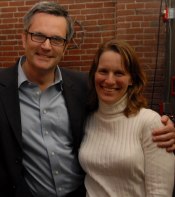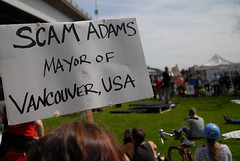
(Photos © J. Maus)
Yesterday I met with Mayor Sam Adams’ Transportation Policy Director Catherine Ciarlo. Ciarlo was the executive director of the Bicycle Transportation Alliance (BTA) from 1998-2005 and is a former member of the Portland Planning Commission.
In a rapid-fire conversation that lasted just about an hour, we touched on several topics, including the Mayor’s Transportation Cabinet, the budget, and the Columbia River Crossing project.
The Mayor’s Transportation Cabinet is a 24-member group that includes representatives from a wide range of interests and perspectives (including of course, bicycling). Ciarlo said the group (whose formation was listed in Adams’ “First 100 Day Action Plan”) is Adams’ “kitchen cabinet” that is full of the people he turns to for strategic advice and to help him set priorities.
“[Sam] believes that bikes are a good investment in the community…and that it’s about health, livability, less wear-and-tear on our streets, etc… All these things don’t have to do with special interest demands but more about what’s good for the city.”
–Catherine Ciarlo
The cabinet met for the second time last night. I was unable to attend, but I spoke to member Chris Smith (Chair of Portland Streetcar Citizen’s Advisory Commitee and former candidate for City Commissioner) about what was discussed. He said there was a fair amount of discussion about bike funding and the budget. Smith told me that Adams will try to hold onto a transportation funding idea he first proposed as part of his failed Safe, Sound, and Green Streets initiative. The idea is to dedicate a portion of the city’s utility franchise fees back to transportation (they were taken away from transportation in the mid 1980s). This revenue stream is said to total several million dollars a year and Smith says Adams might “carve” $500,000 of that money specifically for bicycle and pedestrian programs.
The Mayor is scheduled to release his budget next week and he’s under pressure from the community to find money to restore funding of the popular Safe Routes to Schools program that was cut down 40% from previous years in the Bureau of Transportation’s budget released back in February.
When I asked Ciarlo about what we might expect from the Mayor’s budget next week, she was hesitant to confirm any details. When I reminded her that Mayor Adams made a campaign promise to triple bike funding and make the bike funding match mode share (which is currently 6-8% depending on who you ask), Ciarlo stopped short of saying he’d fulfill that promise.
“Our office would love to see us move in that direction,” she said, “and Sam is committed to seeing us move in that direction.” Ciarlo then said that “he believes that bikes are a good investment in the community…and that it’s about health, livability, less wear-and-tear on our streets, etc… All these things don’t have to do with special interest demands but more about what’s good for the city.” (Ciarlo also said the above could be said for pedestrian spending as well).
Ciarlo and the Mayor’s office have made one thing perfectly clear. When his budget comes out, and if it includes dedicated money for bike funding, he’ll need strong political support to hold on to it.
I then asked Ciarlo about Mayor Adams’ stance on the Columbia River Crossing project. Adams has been in the news a lot lately with strong concerns about the design of the bike/ped facility on the bridge. CRC project staffers have recently put a “stacked bridge” design on the table that would put the bike/ped facility underneath the main bridge — something that Adams and the BTA are opposed to.
Ciarlo said that Adams is “against an ugly design that the community is not supportive of…he wants to come up with a beautiful bridge.”
I shared with Ciarlo how Adams’ opposition to the bike/ped facility design seemed ironic, given that many in the community wished he shown the same concern for the discussion about the size of the bridge. Back in March, Adams reached a controversial compromise plan with Vancouver Mayor Royce Pollard to allow the bridge to be built “to accomodate up to 12 lanes” as long as a new “Mobility Council” was formed to manage traffic on the bridge.
That move shocked and irked many Portlanders, including the BTA, who helped support an anti 12-lane CRC bridge rally and said in a statement detailing their opposition the project that their leaders (which would include Adams) had “failed” them.
Ciarlo defended Adams’ decisions, saying that this project has a lot of different perspectives at the table. “The environment in which we’re working on this is a bi-state environment which includes very different priorities,” she said, “the priorities in Portland are very different than in Vancouver.”
As for Adams’ decision to compromise with Pollard on the lane issue, Ciarlo said that it was made “in a climate of deadlock” and that Adams “believed taking a leadership role was a good trade…where Sam is coming from is a belief that active management is the only way we can get what we want out of this bridge.”
When I asked how their office answers to local advocacy groups that are disappointed in Adams’ decision, Ciarlo said, “Leadership is difficult under any circumstances, but infinitely more difficult when you’re in a situation where not everyone has the same values.”
— Ciarlo and I plan to meet monthly from now on. If you have specific questions or concerns about bike-related issues that you’d like me to bring up, please email them to jonathan[at]bikeportland[dot]org.


